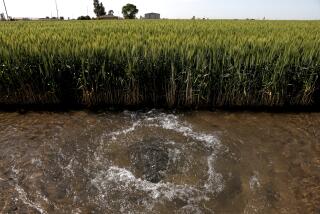Water and Land Development
* Your article on Assemblyman Dominic Corteseâs (D-San Jose) AB 2673, dealing with the relationship between water and land development (Aug. 8), is marred in my estimation by several false assumptions.
The most glaring is that somehow California does not have enough water to sustain its future growth. The fact is that California has more than enough water to satisfy all its foreseeable demands. At high-flow periods, the Sacramento River alone dumps enough surplus water into the ocean in one or two days to serve all the cities in the state for a year. It simply needs to be conveyed and stored against dry periods.
Should environmental regulations so restrict water exports from the Delta as to create a regulatory shortage, much of the shortfall can be made up through water reclamation, the next less costly and firm supply in most urbanizing areas. In many areas of Southern California there are vast stores of ground water that need to be better managed and utilized.
Moreover, the Pacific Ocean stands as an inexhaustible potential supply to most of the major cities of the state and their outlying areas. Cost, of course, is the hurdle for seawater desalination to become a major potable water source. But, the pressures of urbanization, new technology, economies of scale, and comparative costs of alternative sources will most certainly overcome this temporary impediment.
The most damaging assumption, however, is that the restriction of water supply and the failure to meet new housing demand will somehow save the state from future population growth. Pent-up demand for affordable housing is causing excessive congestion in inner cities and even in suburbs, where two and even three families are crowding into single-family units and garages.
WAYNE A. CLARK, Director
Division 5, Municipal Water District
of Orange County
* Where is the California state vision and plan of where we are going? That seems to be the overall theme of each of the three editorials dealing with gambling, water resources and the stateâs business image (Aug. 14). Yet each is presented and viewed as if it is totally independent of one another.
For example, water resources are not unlimited; but what impact does that have on the business image and gambling legislation? These are just a few of the many âislandsâ of planning that are created through stopgap legislation. Why not ask some serious questions about what kind of state is created through stopgap legislation? Why not ask some serious questions about where California is going and create a mission statement and master plan that all legislation must reflect before it is passed?
Regarding water resources, do we want to continue distributing 80% to agriculture, 10% to businesses and 5% to residential users, or do we reduce the amount to agriculture and increase water to business uses to accommodate new growth? Are Californiaâs new business expansion efforts all âdryâ? If business growth is successful, can it be accommodated without a water crisis? Maybe a master plan is what is really needed.
LARRY GODBY
Sepulveda
* Re your editorial, âToward a State of Drought,â Aug. 14: Why are we so at the mercy of the elements? If Saudi Arabia can do it, why canât we build desalination plants off the coast? Give the job to one of the defense contractors with thousands out of work. Do the plants run on solar energy, I wonder?
SANDY GLASS
Los Angeles
More to Read
Get the L.A. Times Politics newsletter
Deeply reported insights into legislation, politics and policy from Sacramento, Washington and beyond. In your inbox three times per week.
You may occasionally receive promotional content from the Los Angeles Times.



![[20060326 (LA/A20) -- STATING THE CASE: Marchers organized by unions, religious organizations and immigrants rights groups carry signs and chant in downtown L.A. "People are really upset that all the work they do, everything that they give to this nation, is ignored," said Angelica Salas of the Coalition of Humane Immigrant Rights. -- PHOTOGRAPHER: Photographs by Gina Ferazzi The Los Angeles Times] *** [Ferazzi, Gina -- - 109170.ME.0325.rights.12.GMF- Gina Ferazzi/Los Angeles Times - Thousands of protesters march to city hall in downtown Los Angeles Saturday, March 25, 2006. They are protesting against House-passed HR 4437, an anti-immigration bill that opponents say will criminalize millions of immigrant families and anyone who comes into contact with them.]](https://ca-times.brightspotcdn.com/dims4/default/34f403d/2147483647/strip/true/crop/1983x1322+109+0/resize/840x560!/quality/75/?url=https%3A%2F%2Fcalifornia-times-brightspot.s3.amazonaws.com%2Fzbk%2Fdamlat_images%2FLA%2FLA_PHOTO_ARCHIVE%2FSDOCS%2854%29%2Fkx3lslnc.JPG)






